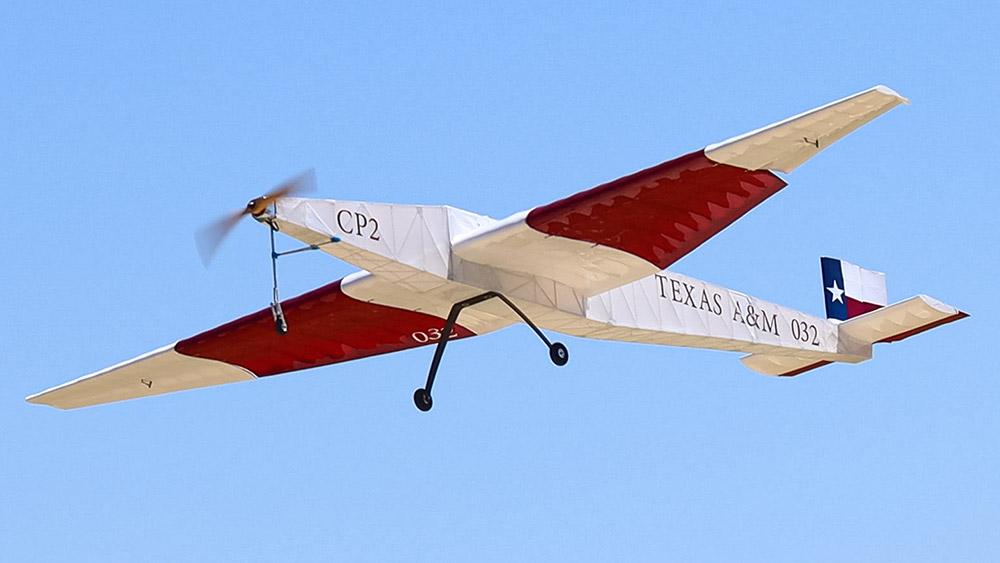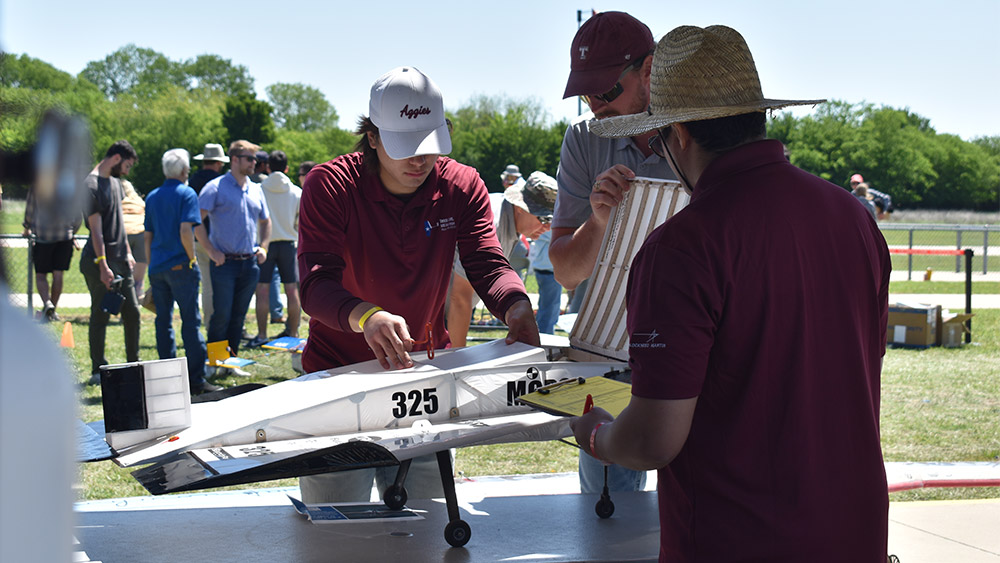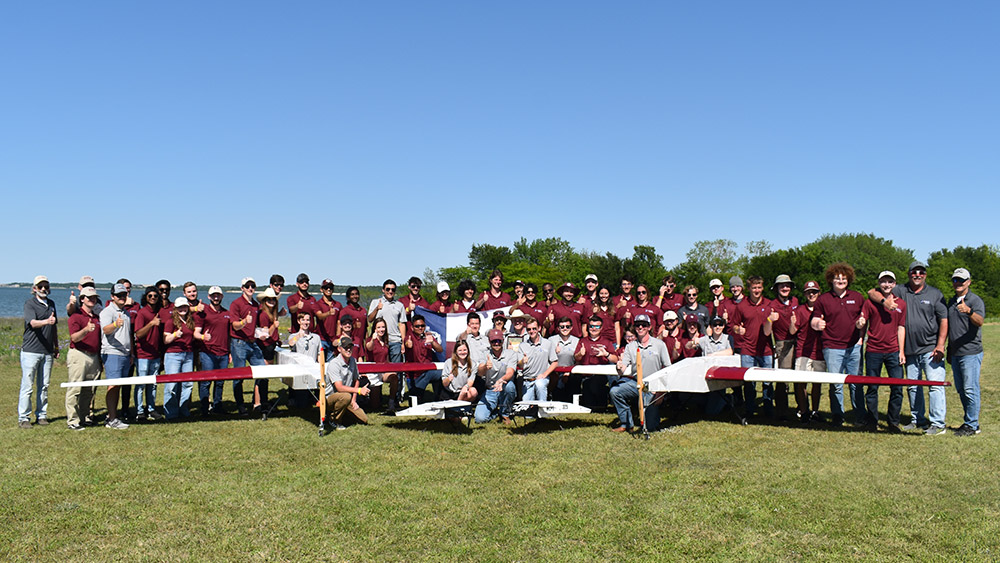Texas A&M University’s Society of Automotive Engineers (SAE) Aero Design teams landed on the podiums again at this year’s SAE Aero Design competition. The Regular Class team brought home another first place overall, making them four-time consecutive international champions. The Micro Class team also earned a spot on the podium, coming in third overall after only two years of competing.
The competition, held on April 14-16 in Fort Worth, Texas, challenged students to design, build and fly a radio-controlled airplane optimized to meet specific configurations and mission requirements.
Leading beyond the flight line
Texas A&M’s Regular Class team pushed the parameters to the limit with their design this year, building an airplane with an 18-foot wingspan. This design helped the team maximize its scores in addition to carrying the maximum, highest-scoring payload weight of 55 pounds, which included steel.
Leading up to the competition, the team completed 15 successful flight tests with no issues. However, during Saturday’s flights, Regular Class struggled to get points on the board. Their first flight crashed with the challenging winds coming off the nearby lake. The winds also caused the nose and tail to break during their second flight. Determined to finish strong, they began rebuilding their planes to return to the flight line on Sunday.

“Instead of crumbling, we rallied,” said Jack Tribolet, an aerospace engineering student and the chief engineer for Regular Class. “We stuck around and managed to finish rebuilding the plane and get it reinspected by the end of the day so we could come out on Sunday and put up a couple good flights.”
On Sunday, the team rolled their large aircraft to the flight line, ready to get themselves back on the board.
Unfortunately, an issue with the propeller prevented their first flight, so they fixed their plane and rushed to get back in line. After all was said and done, Regular Class had one crash, two disqualifications and two successful flights. Impressively, Regular Class still came in second in mission performance and missed first place by only 0.1 points despite only having two successful flights compared to some of the other teams’ three flights. Their ability to engineer a design capable of maximizing scoring potential also awarded them second place in design report, leading them to become four-time consecutive international champions.
“We sat down at the awards and were ready to cheer on the other teams knowing we had done everything we could to get successful flights,” said Izzy Short, an aerospace engineering student and the director of Regular Class. “It was a really cool experience seeing everything come together in the end and everyone’s hard work pay off the way we were hoping it would.”
Rise from the wreckage
For the Micro Class category, teams were limited to a 3-foot wingspan, and their planes were expected to take off from an 8-foot table. Their aircraft then had to circle back and land on the runway while carrying a payload of boxes and plates. Each flight was scored by an equation that divided size and weight by the amount of time it took to fly 300 feet, so speed was critical for maximizing points. Last year’s Micro Class team made the run in 20 seconds. This year, they lowered their time to less than eight seconds, which significantly improved their score.
On the Micro Class team’s first flight on Saturday, the plane took off from the table and made the first turn before falling out of the sky halfway through its flight because of an electronic failure. On the second flight, it did a complete circuit but rolled off the runway into the grass by a couple of inches, disqualifying the otherwise successful flight.
“Definitely not how you want to start the competition,” said Jeremy Ringwood, a mechanical engineering student and the director of Micro Class. “But we said, ‘Okay, let’s keep our heads up. Let’s stay optimistic here. It’s still early in the competition.’”

Micro Class’ third flight went smoothly, but while unloading the payload, they lost points on their score because of an issue with how the plane was loaded.
Determined to get another flight in before the day was done, they got back in line. Like their first flight, the plane made the first turn successfully, but the rudder broke off the aircraft and interrupted the left-side aileron, putting it into a roll going into the ground.
“At this point, we’d had four flights where nothing had gone our way,” said Hunter Hadden, an aerospace engineering student and the chief engineer of Micro Class. “We pulled our heads together, took our two broken planes and molded the pieces of wreckage into a Franken-plane so that we would have at least two planes to fly on Sunday.”
Their tenacity paid off, and Micro Class pulled through with three high-performing flight scores, which, when combined with their third place in design report, landed them third place overall.
An engineer’s education
Although they felt the pressure at the competition this year, the students gained valuable experience that will prepare them for their future careers.
“It’s a really good technical experience to have as an engineer,” said Ringwood. “In classes, you learn a lot of theory, and it’s good to have that backbone, but it’s very different from having an actual airplane in your hands that you have to put on the flight line. You also learn a lot about teamwork and getting those small moving parts fitted into the same larger picture.”
Texas A&M’s SAE Aero Design teams are supported throughout the year and at the competition by advisors who help cultivate these leadership and learning opportunities for the students. This year’s advisors included Scott McHarg from Texas A&M’s Department of Aerospace Engineering, who also piloted the planes, Dr. Jay Grinstead, also from the aerospace engineering department, and Dr. Dale Cope from the J. Mike Walker ’66 Department of Mechanical Engineering.
This year’s teams comprised more than 60 students from multiple departments, including the aerospace engineering department, the mechanical engineering department, the Department of Computer Science and Engineering, the Department of Electrical and Computer Engineering and the Department of Engineering Technology and Industrial Distribution.
